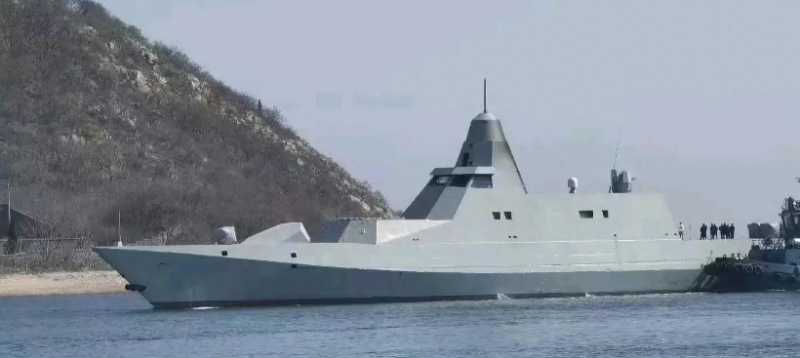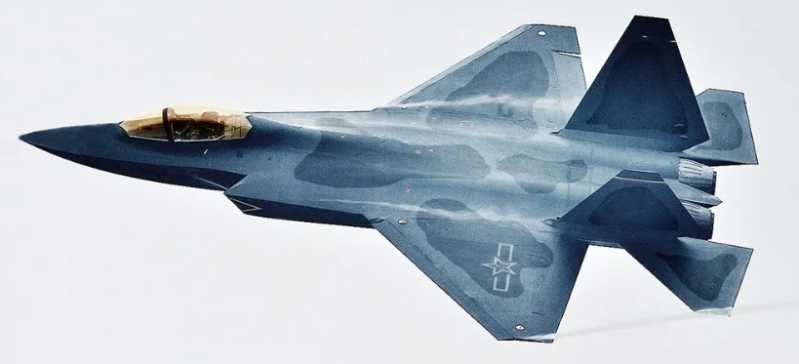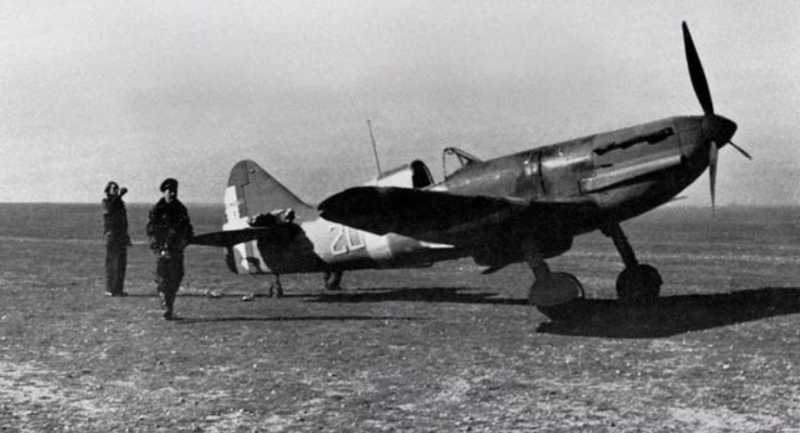On July 25, 2023, the Iranian Navy and the Islamic Revolutionary Guard Corps Navy (IRGCN, a paramilitary naval department parallel to the traditional Islamic Republic of Iran Navy) unveiled a new anti-ship cruise missile called "Abu Mahdi". According to Iranian official media reports, the range of the "Abu Mahdi" missile can reach 1,000 kilometers. The missile is also the first cruise missile designed by Iran to use artificial intelligence technology in the missile flight path and command and control system, which greatly improves the maneuverability and accuracy of this type of missile. After launch, the missile can fly according to the predetermined trajectory, and can also re-plan the flight route according to the battlefield situation and strike targets from different directions. This missile is expected to significantly enhance Iran’s ability to control the Persian Gulf region.
Overview of the development of Iran’s anti-ship cruise missiles
From "Sumur" to "Hoveizeh"
Iran has always been committed to the development of domestic weapons and equipment. Iran has achieved a certain degree of localization in everything from assault rifles to ballistic missiles and launch vehicles, and has established a relatively complete military production system. As early as 2005, Iran obtained 12 Kh-55 cruise missiles left by the Soviet Union from Ukraine, and then launched a reverse imitation plan to produce such missiles in the country. In 2015, Iran demonstrated the "SOUMAR" cruise missile. However, this missile is very different from the KH-55. For example, the missile does not use the retractable engine of the KH-55, but a fixed hanging engine, and is also equipped with a solid booster with a grille tail for land launch. The missile is about 7 meters long and 0.5 meters in diameter, and is equipped with a turbofan engine. Judging from its subsequent actual combat performance, its range still does not reach the level of the Kh-55 cruise missile.
Later, on the eve of the 40th anniversary of the victory of the Islamic Revolution, the Iranian military also exhibited a new type of Hoveyze cruise missile, which has a range of more than 1,350 kilometers. Unlike the "Sumur" missile, which is assembled with imported parts, the engine of the "Hoveyze" cruise missile may be changed to Iran’s domestically produced "Dawn"-4 turbojet engine. Since the performance of Iran’s domestically produced turbojet engine is far inferior to the original turbofan engine, the range of Iran’s domestically produced missile is more than a thousand kilometers longer than the KH-55 missile.
"Noor" anti-ship cruise missile
Before this, the main anti-ship weapon of the Iranian Navy was the "Noor" anti-ship cruise missile. The missile uses a semi-armor-piercing high-explosive warhead, which can penetrate the external armor of most ships, with a maximum flight speed of 0.9 Mach and a maximum range of 200 kilometers. It can fly at an altitude of 10 to 20 meters above sea level.
According to the Iranian News Agency on November 27, 2023, the Iranian Navy held a commissioning ceremony for the fifth "Jamaran" class destroyer, the "Deylaman", in the northern Iranian port city of Bandar Anzali. The "Deylaman" (hull number 78) has a welded steel hull, is 94.5 meters long, 11.07 meters wide, has a draft of 3.25 meters, a full load displacement of 1,540 tons, is equipped with two 7,500-kW 16YJCM diesel engines and four 740-horsepower (550-kW) diesel generators, a maximum speed of 30 knots, a cruising range of 5,000 nautical miles/15 knots (questionable), and a crew of 146 people. The four-shield radar installed on the main mast should be Iran’s S-band Hawkeye active phased array radar. It is said that it uses 1,000 T/R components, has a detection range of 200 kilometers, and a detection altitude of 30 kilometers. It can detect the target state in less than 1 second, quickly change the frequency and analyze the interference signal, and transmit the information of various targets to the ship’s command system and guided missiles. The radar can detect more than 100 targets and lock 12 targets at the same time, discover, identify and intercept targets such as ships, aircraft, helicopters, drones and cruise missiles, and can destroy targets with a radar cross-section of 4 square meters at a long distance. The ship’s weapons and equipment include a Fajr "Dawn" 27 naval gun at the bow, which is a copy of the Oto Melara 76mm dual-purpose gun, with a firing rate of 120 rounds/minute, which can strike sea and air targets, with an air range of 7 kilometers, a maximum sea range of 17 kilometers, and a ground target range of 12 kilometers. Two quadruple-mounted "Kader" anti-ship missiles (stretched version of "Noor") are installed in the middle of the ship. This missile is 6.843 meters long, 360 mm in diameter, 1.22 meters in wingspan, weighs 770 kg, and is equipped with a 155 kg semi-armor-piercing warhead. The maximum flight speed is 0.9 Mach, the cruising flight altitude is 20 to 30 meters, and the attack flight altitude is 5 to 7 meters. It uses inertial guidance plus active radar terminal guidance, and the range reaches 15-300 kilometers.
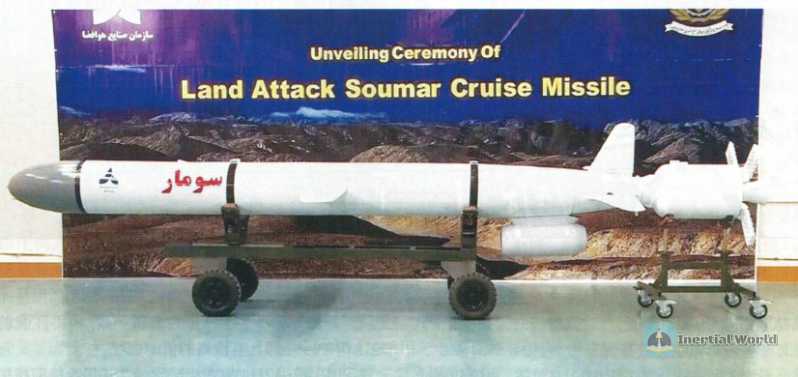
Navy "Abu Mahdi"
Considering that the current US and European anti-ship missiles already have supersonic anti-ship combat capabilities, in comparison, this missile has ordinary performance and limited upgrade potential. Therefore, Iran has begun to develop the "Abu Mahdi" anti-ship cruise missile to make up for its shortcomings.
On August 20, 2020, the naval version of the "Khoveizeh" cruise missile, the "Martyr Abu Mahdi" anti-ship cruise missile, was unveiled, with a range shortened to 1,000 kilometers. The missile is named after the late Iraqi militia commander Abu Mahdi al-Muhandis, who was killed in a US military operation near Baghdad International Airport in January 2020, along with former Islamic Revolutionary Guard Corps Quds Force Commander Qassem Soleimani.
It is reported that the first batch of 600 "Abu: Mahdi" anti-ship cruise missiles delivered to the Iranian army will be deployed first on the Iranian Navy’s combat ships and along the Strait of Hormuz to deal with the threat of foreign ships.
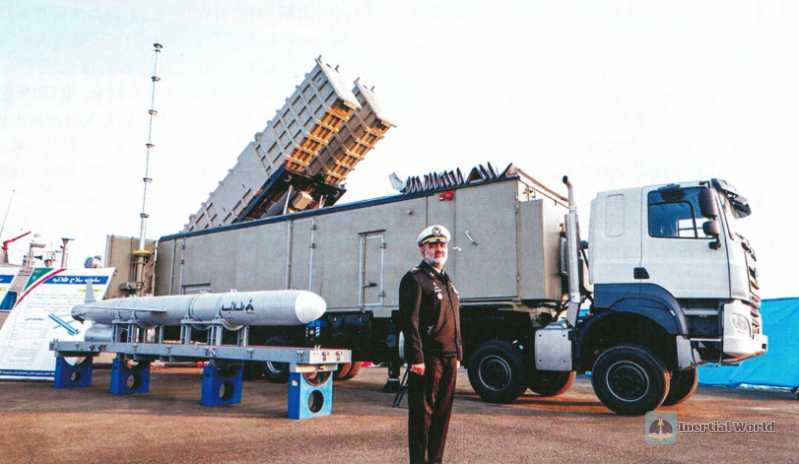

Iran is eager to develop and deploy the "Abu Mahdi" anti-ship cruise missile, the main purpose of which is to safeguard territorial sovereignty and enhance regional discourse power. However, the actual performance of the "Abu Mahdi" anti-ship cruise missile has not yet been tested in actual combat, and its future performance remains to be seen. At the end of December 2023, the Iranian Navy received the vehicle-mounted version of the "Talaye" cruise missile, which is the naval version of the "Abu Mahdi" cruise missile.
"Quds" series anti-ship missiles
In addition, according to Reuters on September 21, 2023, the Yemeni Houthi armed forces displayed a large number of missiles and armed drones at a large-scale military parade held in the capital Sanaa. Among them are two new cruise missiles, namely the Quds-4 cruise missile and the Quds Z-0 anti-ship cruise missile, which are the latest products of the Quds series of cruise missiles. It is worth noting that both missiles have strong Iranian origins. On June 7, 2019, Huhan armed missiles attacked Abha Airport in Saudi Arabia. On July 12, 2019, the Huhan armed forces in Yemen announced the Quds-1 cruise missile and claimed that the previous attack was carried out with this missile. The overall design of this missile is similar to that of Iran’s Sumur missile, but it is much smaller. The missile does not use the internal folding wings in the middle of the missile body, but uses a fixed straight lower wing at the bottom of the missile body. It also uses a suspended engine, which is smaller. The tail wing of the booster is also a very special cut-angle trapezoid. It focuses on a simplified design, which has the advantage of not requiring too high a process and is cheap. When the wreckage of this missile was dismantled by the Saudis, it was found that it was equipped with a TI-100 jet engine produced by the Czech PBS Aerospace company. The TJ100 engine is a single-shaft small turbojet engine consisting of a radial compressor, radial and axial diffusers, annular combustion chamber, axial turbine and fixed outlet nozzle. It is developed for drones, suicide drones, light sport aircraft and gliders with additional engines. This engine is compact in design, low in weight, with an outer diameter of 272 mm, a length of 636 mm, a weight of 17.6 kg, a thrust of 1250N, and low fuel consumption for a given power category. Then according to the proportion, the body diameter of the "Quds"-1 may be only 340 mm and about 5.4 meters long. Interestingly, Iran has copied this engine, called T-10S, and it is likely to be provided to the Hu Han armed forces. Therefore, the range of this missile may be only 700-800 kilometers, using inertial navigation plus GPS civil code guidance. As for the manufacturer, it is more likely that Iran directly assembles the parts, in simple terms, it is Iranian goods OEM.
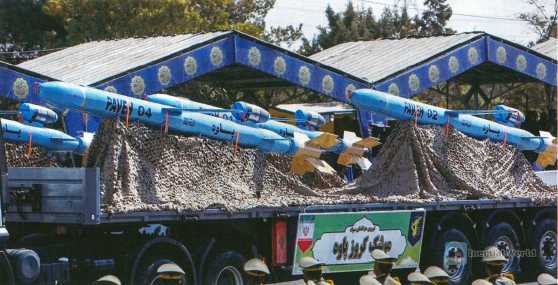
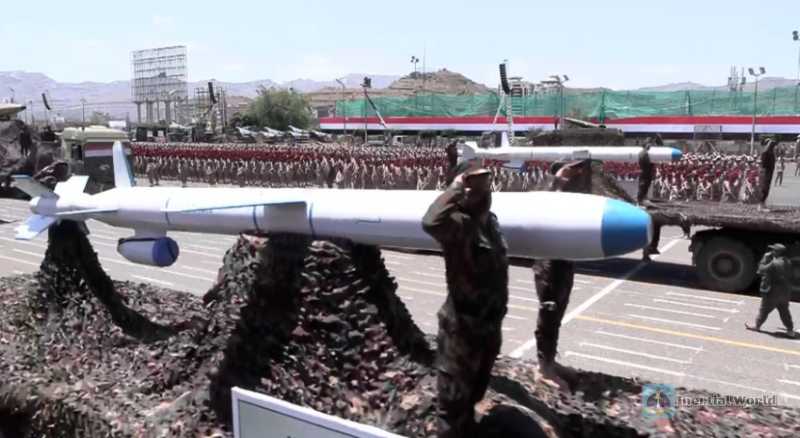
The Houthi armed forces displayed the Quds-2 and Quds-3 cruise missiles in the subsequent military parade. The body of the Quds-2 is obviously longer, and the body of the Quds-3 cruise missile is thicker and longer. The shape of the engine has also changed significantly. Obviously, the new engine has been replaced, and the range will be longer. Interestingly, Iran released a video of the new PAVEH cruise missile on February 24, 2023. It is reported that its range is 1,650 kilometers and it also uses a lower single wing. Obviously, the range of the two should be the same. This time, the Quds-4 missile body was further lengthened. On September 21, the Islamic Revolutionary Guard Corps showed Shoigu an "unnamed" long-range cruise missile for the first time. Although this missile is painted black, its layout is obviously from the Quds series, which also confirms its Iranian origin. The performance of these two cruise missiles is unknown, but the range will continue to increase. It is speculated that it should have reached 2,000 kilometers. The appearance of the Quds Z-0 anti-ship cruise missile displayed by the Houthi armed forces is not much different from that of the Quds-4, so the performance is similar. The biggest difference between the Quds Z-0 anti-ship cruise missile is that it uses an optoelectronic or infrared seeker, but this requires the missile’s mid-course guidance accuracy to be high enough, and the target’s coordinates to be precise enough. The fact that the Hu Han armed forces can come up with a new cruise missile this time also shows that its trade channels with Iran are smooth enough. It can be foreseen that Iran will be equipped with both the Abu Mahdi series of anti-ship cruise missiles and the Quds series of cruise missiles to achieve performance complementarity.
"Abu Mahdi" performance analysis
"Abu Mahdi" anti-ship cruise missile is about 6 meters long, about 550 mm in diameter, 3.1 meters in wingspan, 1,650 kg in weight, 410 kg in warhead weight (high-explosive warhead), and has a flight altitude of less than 50 meters. The accuracy of the hit is 3 meters CEP. The missile is mainly composed of a missile body, a power unit, a guidance device, and a warhead. Among them, the missile body includes the missile body, wings, tail fins, rudders, etc. The missile is launched from the ground and requires a solid booster to provide the initial speed and altitude. The "Hoveize" cruise missile directly hangs the engine under the tail of the missile body, which not only avoids the complex design of the extended air intake, but also avoids the engine occupying the missile body space, increases the fuel load, and increases the range. However, such a design is easily detected by enemy radar.
The guidance device may be a composite guidance system, including an inertial navigation system, a GPS-assisted correction system, terrain matching guidance, and a radar altimeter system for low-altitude flight. According to Tasnim News Agency, at a procurement commemoration ceremony attended by senior military dignitaries, Ashtiani emphasized that the "Abu Mahdi" missile enables Iran to effectively counter electronic warfare exercises while cleverly avoiding radar systems. In addition, the missile’s advanced capabilities enable it to autonomously draw the best flight trajectory. The missile flies at a very low altitude, making it more difficult to detect and intercept, and has a "dual seeker" that enables it to counter electronic countermeasures. The dual radar seeker has active and passive modes, and the guidance system uses artificial intelligence to draw a flight path through a series of waypoints, enabling it to exploit gaps in enemy air defense coverage and allow multiple missiles to approach the target from different directions at the same time. With the help of artificial intelligence technology, this type of missile can analyze data in real time, adjust the flight trajectory, and more effectively evade the opponent’s air defense system; it can also make autonomous decisions, optimize the flight path, and improve the success rate of the mission.
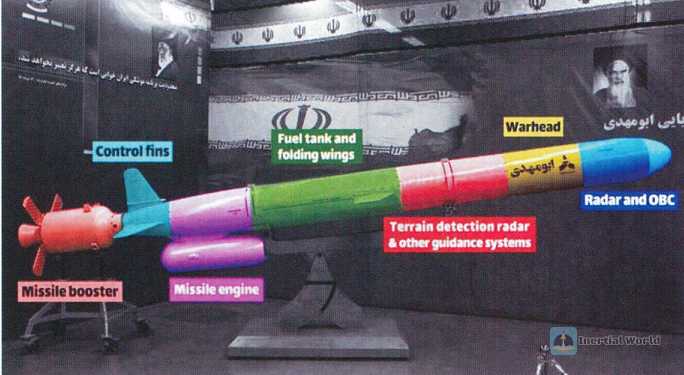
The use of artificial intelligence technology shows that Iran is committed to strengthening its military capabilities to make up for the shortcomings of its maritime and air combat capabilities. First, artificial intelligence can improve the accuracy of strikes by analyzing and adjusting trajectories in real time, which helps with precise targeting and reducing collateral damage. Second, artificial intelligence also provides missiles with autonomous decision-making capabilities and can adaptively respond to dynamic environments and communication interference. This adaptability is crucial, especially in countering electronic countermeasures and adapting to unexpected target movements. At the same time, after the introduction of artificial intelligence, missiles can identify and evade anti-missile defense systems, thereby increasing the chances of mission success. Third, artificial intelligence technology can extend the range and flight time of missiles through fuel management and trajectory optimization. Fourth, artificial intelligence can process reconnaissance data in flight and adjust missions based on updated information, which is crucial to the accuracy and relevance of attacks. Finally, by reducing the need for direct human control, artificial intelligence also reduces the risk to operators while ensuring better interoperability with other weapon systems, which is the basis for efficient coordination in complex military operations. In short, artificial intelligence gives cruise missiles greater flexibility, higher efficiency and greater power, and plays a key role in the evolution of naval military capabilities.
The missile adopts a blunt head, a cylindrical body in the middle (the tail is retracted), and a "straight" large aspect ratio medium sweep angle folding wing is installed in the middle of the body. The tail of the missile adopts a "human" tail wing aerodynamic design. The advantage of the blunt head is that it can increase the available space and shorten the total length of the missile; the large aspect ratio medium sweep angle folding wing is folded in the wing storage slots on both sides of the body, and automatically unfolds after launch. This kind of wing has a large lift in the subsonic range and a small induced drag, so the lift-drag ratio is relatively large, which can provide the lift required for long-range cruise flight, which is beneficial to increase the range of the missile. The advantage of the "straight" layout is that it has low drag and light weight. When the missile uses coordinated turns, the lift is always aimed at the target. The warhead can adopt a directional explosion structure, which is beneficial to reduce the weight of the missile. However, its disadvantage is that when the speed exceeds the speed of sound, the shock wave drag will increase sharply, so it is not suitable for faster missiles. The Khoveize cruise missile uses a face-symmetrical wing surface, that is, a 120-degree "human" configuration, which is characterized by providing sufficient heading stability, but when there is a side slip angle and an angle of attack, a significant rolling moment will be generated. The solid booster is equipped with four grid-type tail fins. One of the advantages of grid wing is that the lift is greater than that of a relatively flat wing. The more grids there are, the greater the lift. Because of their shape and small chord length, grid wings are easy to fold and occupy less space when folded. They can be folded forward radially and opened directly by air resistance after launch. This folding makes the weapon more compact and easier to store or transport. Given that Iranian cruise missiles mainly fly at subsonic speeds, the main advantages of their grid wings are easy packaging, easy opening after launch, and simple structure, rather than low drag or increased control effectiveness. The main targets of the missile are missile bases, weapons depots, troop assembly areas, airfields, naval bases, command and control centers, transportation hubs, etc.
The main advantages of this missile are high accuracy, long range, and maneuverable launch. The missile is stored in a rectangular launch box. Since the missile engine is mounted outside the missile, the required launch box is relatively large. One launch vehicle carries two missiles. The launch vehicle looks like a civilian box truck, making it more concealed. The missile has the function of targeting enemy ships from deep in the land and countering enemy electronic warfare. According to the Iranian military warning, this missile will be able to completely destroy enemy ships near the Iranian coast and force the enemy to stay away from Iranian territorial waters. Iran’s determination and military strength are highlighted in this news, which is of vital significance for maintaining Iran’s territorial integrity and national security
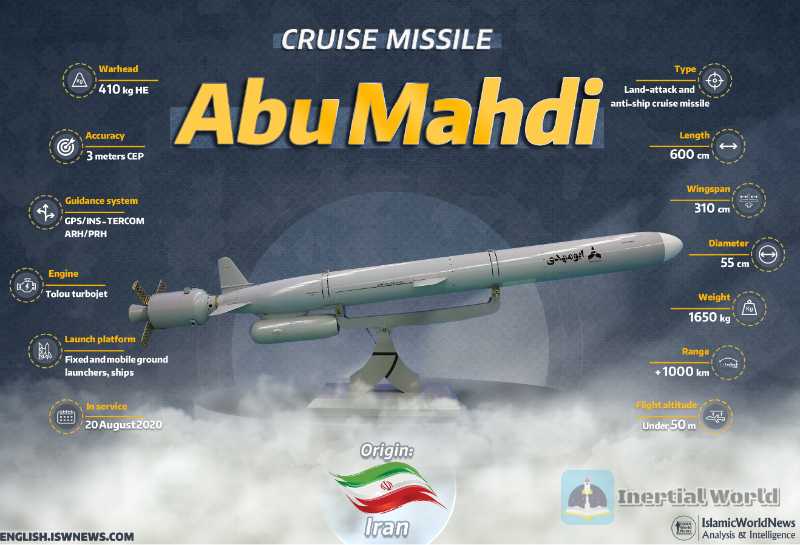
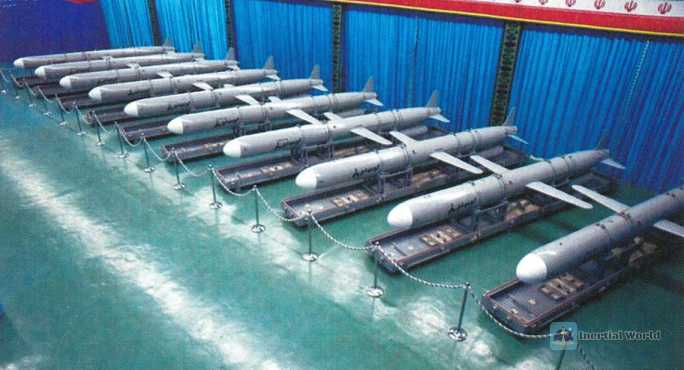
Equipment significance
As an important country on the coast of the Persian Gulf, Iran is well aware of its geographical strategic importance and is clearly aware that the Strait of Hormuz is the maritime lifeline on which the United States and other Western countries rely for survival. Therefore, Iran is unwilling to become a puppet of any country or a passive participant in the situation, but takes active actions to defend its national interests. In terms of foreign policy, Iran has always insisted on maintaining regional stability through deterrence. Iran has made it clear that the deployment of the "Abu Mahdi" cruise missile is to protect the homeland and force enemy ships to stay away from the Iranian coast rather than actively seek conflict. If the enemy dares to provoke and invade again, Iran will resolutely fulfill its promise and rely on the ultra-long-range strike performance and powerful destructive power of the "Abu Mahdi" cruise missile to effectively strike the enemy fleet and block the entire Strait of Hormuz and the Persian Gulf when necessary. The missile has ultra-long strike performance and powerful destructive power. The Iranian military has the ability to block the entire Strait of Hormuz and the Persian Gulf, making the US Fifth Fleet stationed in the region ineffective. Iran’s determination and foreign policy are to protect the security of its homeland and maintain territorial integrity. Faced with continued regional tensions and pressure from Western countries, Iran has taken a series of defensive measures to ensure national security and stability. The development of the "Abu Mahdi" cruise missile is part of this, which is intended to send a strong deterrent signal to potential enemies. In short, for Iran, protecting its homeland security is one of the most important tasks. By possessing independently developed high-precision missiles and drones and other weapons and equipment, Iran has demonstrated its strength and taken measures to ensure regional stability.






